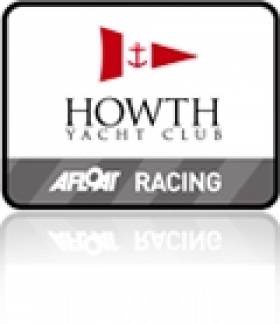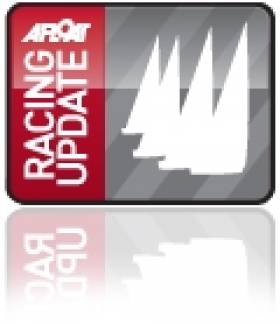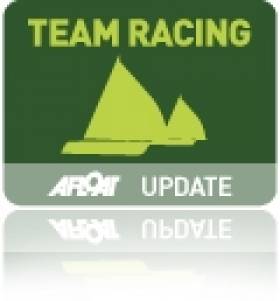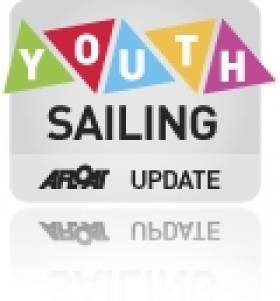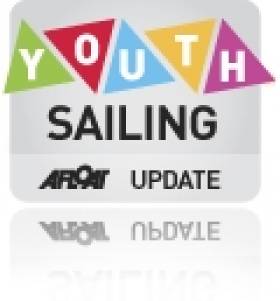Displaying items by tag: Howth Yacht Club
Lambay Race Win for 'Bite the Bullet' off Howth
#lambay – Howth Yacht Club's 2014 Lambay Races were supported by a keen fleet of almost 120 boats, from the modern day stripped-out racers to equally spartan machines of 1898 writes Emmet Dalton. The Howth 17 Footer and Old Gaffer fleets avoided the nasty, modern business of a beat to a windward mark and started a half hour earlier from Howth's East Pier and made directly for Lambay. Selected results available to download below.
Meanwhile, their younger brethern, forever spending money trying to go faster, spent additional time sailing in the wrong direction from inshore and offshore start lines towards windward marks before deciding to turn towards the target.
Exotic materials are never a guarantee of success as the "Back" of Lambay snorted its usual laugh at the leaders. Skippers who bit off five metres too much or little towards the crags were rewarded with nothing more than gull droppings on their decks or inadequately muffled slagging from their faster moving neighbours.
The early part of the day didn't hold out much promise of the golden orb breaking through but as the race progressed and the rounding of a fog-cloaked Lambay was completed, there was enough sun to allow the salt to caulk on the faces of those closer to the front of boats.
This term's Top Boy was Colm Birmingham and his chums who took "Bite the Bullet" on a faster field trip than the other classes, bagging the (Anatomically perfect) Lambay Lady.
From our 17 Footer reporter, Mary Faherty:
Rita took the lead at the start. However Ian Malcolm's Aura overtook her just past Claremont Beach followed closely by Oona. Then the whole fleet disappeared into the heavy fog. Lambay was no where in sight and everyone was guessing compass bearings. When the sun finally broke through the fleet was just to the east of Lambay, again with Rita just in the lead. She held her position and rounded Lambay in first and finished a whooping 4 minutes ahead of the next boat. Oona and Aura raced for second place on the water. Hugh Walsh who had taken Sheila for the race and walked away with the handicap prize
Details from the Puppeteer 22 Class Captain, Cabbage Kavanagh:
In the Puppeteers the 14 boat fleet started with a short beat, rounded the windward and headed into the mist in search of the eastern end of Lambay. As always the racing was tight. After exchanging the lead several times, Eclipse slipped ahead of Blue Velvet behind the island and held on to take the BP/Teeling trophy on scratch, with Harlequin in 3rd and Odyssey squeezing in 4th, showing good speed on one of their first outings of the season. In the handicap division experience told with Cloud 9, rumoured to have competed in every Lambay race since 1906, taking the John Pearson cup, ahead of Schiggy in 2nd, Enigma in 3rd, doing well on their first attempt at Lambay, and Geppetto in 4th.
#hyc – This weekend, Saturday June 7th, Howth Yacht Club once again hosts one of Ireland's longest established events, the Lambay Races. The event has been part of Howth's sailing calender for well over 110 years, the first trophy dates back to 1899 and was put up by a member of what was then Howth Sailing Club.
Saturday's event is proudly sponsored again this year,by Trustee Decisions Ltd. - a specialist company providing professional advice to trustees of private and public group pension schemes.
Apart from the usual inshore and offshore fleets, HYC will also have a throwback to the traditional Lambay races with the Howth Seventeens starting off the east pier and finishing in Howth Sound. The return to the tradtional Lambay course was discussed recently in WM Nixon's Sailing blog.
There will also be a pier start for classic boats which will hopefully include a Galway Hooker.
This change in format for traditional classes is the idea of Bryan Lynch and is to mark the centenary of Echo (no. 8) which has been in the Lynch family since 1969 and is currently owned and skippered by Bryan's daughter Harriet.
As the entries roll in, it seems that the Puppeteers will end up being one of the biggest fleets. Every inch of the 16 or so mile race track will likely be needed by whomever will end up claiming the Lambay Lady trophy, which is awarded to the boat that wins its class by the largest time differential over the boat that comes second.
Leaving aside the excellent racing that the event usually provides, the onshore festivities start early on Saturday morning with coffee and bacon rolls, bar food and barbecue available all day, the prize giving will take place at 17:30 and dinner is available in the dining room from 18:00 (booking essential).
Music and dancing will be provided by Buck Taylor, a James Taylor tribute act with DJ David O'Shea continuing the fun until late.
Entry is available on line here
#etchells – Ireland has a single entry in a 95–boat fleet for the 2014 Etchells keelboat World Championship from June 21 to 28 in New York. The class's 46th world championship will be one of the biggest and most competitive in its celebrated history.
Malahide and Howth Yacht Club sailing family trio, Richard, David (a four time Olympian) and Samantha Burrows are entered in the Corinthian, Masters and Seniors divisions in a fleet that has already attracted some of the world's top professional and amateur sailors.
Long Island Sound yacht designer and builder Skip Etchells created the 31-foot keelboat in 1965 hoping to win selection as the new Olympic keelboat.
The design dominated the racing in the selection trials, but lost in the onshore voting for Olympic status. For the 2016 Olympics, there will be no keelboat sailed in the Olympic regatta.
But nearly 50 years after the first Etchells touched the water, the class is as strong as ever.
The number of entries in recent class world championships has varied from 41 last year to a high of 100 in 1998.
Up to nine races are scheduled, all but one of which will count toward a team's final score. Registration and measurement for the regatta will start on Saturday, June 21, with the racing taking place on Rhode Island Sound, Tuesday, June 24, through Saturday, June 28.
For an entry list click here.
#hyc – Simplify the courses, make the starts more accessible, and sign up interesting boats, ideally with historical interest - those are some of W M Nixon's suggestions for stimulating sailing.
They're going back to their sailing roots in Howth. The historic Lambay Race in a fortnight's time will re-introduce the traditional direct course round the island for both the venerable Howth Seventeens, and a special class for Classics and Old Gaffers.
The annual race round Lambay has been a part of the local sailing calendar for at least 110 years. With the first known Howth regatta being staged in 1857, doubtless the island was used as a very clearcut race mark several times during the 19th Century. But it wasn't until 1899 that a Lambay trophy was finally put up by a member of the relatively new Howth Sailing Club (founded 1895), and it is 1904 before we find any reference to such a race being held.
Howth SC was a tiny club, and the earliest records of its sailing results are very sketchy. To keep the tally, they often ended up relying on inscribed trophies and the occasional newspaper reports. But trophies went missing, and with the big clubs on Dublin Bay and Cork Harbour getting any media attention going, Howth scarcely registered on the newspaper radar at all. Then with six members – or more than 10% of the active membership – killed during the Great War of 1914-18, there were other things to think of, and it isn't until the 1920s that we have anything like a clear idea of what was going on with the Lambay Race.
The way it was reported suggests that it had been a well-recognised event since the early 1900s, and the course was firmly established. Start off the pierhead (time to be taken from Findlater's clock), through the Sound leaving Ireland's Eye to starboard, then round Lambay leaving it to port, and back to the finish through the Sound, this time with Ireland's Eye to port. It's only about 16 miles in all, but it can be a course with a bit of everything.
And it was so beautifully simple - even the business of hitting the main mark of the course didn't merit disqualification as you were aground, and had more than enough problems to be going along with, without being chucked out of the race as well.
It was a format which worked well until the 1970s, when fancy notions of always having windward starts from a committee boat, with all sorts of other course permutations round laid marks, were added to the ancient mix. This new approach worked well enough for a while, as sailing numbers were increasing in any case. But the new devotion to serious racing began to stray from the old Lambay ideal of celebrating a coastline by racing round its main island.
Thus at a time when the straightforward Round Gotland Race in Sweden was building its steady rise to becoming the Baltic's most populous sailing event, and the equally straightforward Round the Island race round the Isle of Wight in the south of England was doing the same in the Solent, the much longer established Lambay Race in Ireland was straying further and further from the attractive simplicity of its original concept. Gung-ho Race Officers, obsessed with the ideal of the Olympic-style course, began setting ever-more artificial courses in which Lambay was so much reduced to being merely another mark of the course that, on one eminently forgettable occasion, the fleet didn't actually round the island at all.
My own disenchantment with the new regime came on a day of light westerly winds, when a Race Officer obsessed with fitting in a long windward leg set a Lambay Race course which also took in the Kish Lighthouse eight miles offshore. As it happened, our crew included two guys who had to be in Athlone that night by 9.30pm in order to play a weekly gig with a showband. In those pre-motorway days, just getting to Athlone was a night's work in itself. So when the breeze faded, we'd to pull out so they could get to work on time.
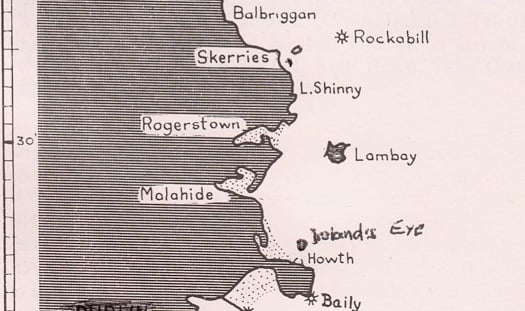
What could be simpler? A basic course using Lambay as the turning mark removes cockpit confusion
As it happens, the breeze filled in just enough for those still racing to complete the course minutes ahead of the absurdly late time limit of 8.0pm. With the calm in the middle, and then the better wind filling in later, the handicap placings were simply the reverse order of boat size. The smallest boat won, and as we were the second smallest boat racing, had we been able to stick at it we might have been at least second. Yet the disgruntlement wasn't directed at the demands of showband gigging in Athlone. On the contrary, the annoyance was with race officers who think that even the most traditionally fun-filled racing celebration of a beloved island and its nearby area of Irish coast should be made such a deadly serious business.
Just now and again, we need to lighten up in our sailing. By all means be vigilant in safety and in respecting the rules of the road in seafaring. But for heaven's sake just once in a while, let's race a simple course along attractive bits of coastline as much for the fun of being among other boats and sailing the sea, and the beauty of the coastline, as for the competitive sport involved.
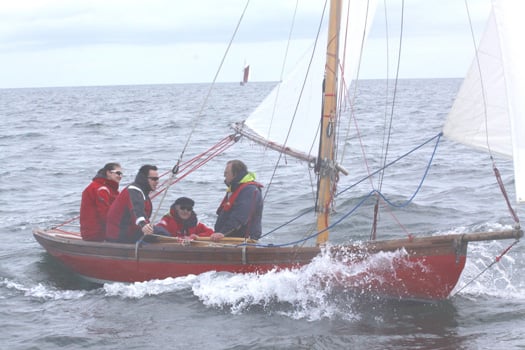
The folk who have made it happen. Harriett Lynch on Echo's helm (left), with her father Bryan second from right. Our photo shows them last year as they were about to demonstrate to the Old Gaffers how to do it, by sailing their engine-less little boat round the Kish despite forecast of calms. This year, to celebrate Echo's Centenary, they and the rest of the Howth 17s will sail a traditional course round Lambay. Photo: Dave Owens
For this year's Lambay Race on Saturday June 7th, there's a glimmer of fresh hope. Bryan Lynch is a stalwart of the Howth 17 class. He has been involved with these attractive little boats since at least 1965, when he and his brother Mark bought Pauline, No 2. Then they were out of ownership for a little while, but soon back in together again with Echo (No 8) in 1969, and then in 1974 Bryan became Echo's sole owner as Mark had bought Eileen (No 16).
They were adventurous times for the Seventeens, as the Lynch brothers, in addition to the regular summer programme at Howth which provides the class with 60 races every year, also cruised with two of the boats to Ardglass and the Isle of Man. So although Mark has now moved on to a "plastic gaffer", the 22ft Cornish Crabber Alice, Bryan continues in the Howth 17s although these days the owner-skipper of Echo is his daughter Harriet.
Last year when the Old Gaffers were celebrating their Golden Jubilee in Dublin Bay, the Seventeens showed their mettle with the main fleet racing round The Baily to the celebrations at Poolbeg and in the Liffey, but the Lynches with Echo, together with Ian Malcolm in another Seventeen, Aura of 1898 vintage, elected to have a match race round the Kish even though the inaugural DBOGA race for the Leinster Plate, which might have raced to the Kish, was shortened to the North Burford as lighter winds were forecast.
But the two little Seventeens found enough breeze to get there and back. Ian Malcolm had brought along an outboard just in case, but Echo and her gallant crew were entirely wind-reliant, and it was the successful beginning of a buildup to this year's big celebration, which is Echo's Centenary.
She was built in Dublin by Hollwey of Ringsend in 1914, and to mark the special year, Bryan Lynch requested that for the 2014 Lambay Race, the Seventeens be sent on the traditional course which Echo will have sailed in her maiden season in 1914.
He found he was pushing on an open door. Not only have the grand fromages in Howth Yacht Club willingly agreed, but now they've leapt at the idea of having a start for classics and traditional boats over the old Lambay course as well, also starting off Howth's East Pier. The start gun for the Seventeens will be at 1130am on Saturday June 7th, and the Classic & Gaffers at 1135am, or maybe with all those bowsprits milling about, they might allow a full ten minute gap. Whatever. But who knows, there might even be enough interest for other cruisers who want more of the simple old course, to be given a gun five or ten minutes after that again.
This all means there's been a revival of interest in the Lambay Race of 1921. Thanks to an article in the annual Journal of the Humber Yawl Club for 1922, that's the earliest detailed record we have of the cruisers' section in any Lambay Race. The winner was John B Kearney's 36ft gaff yawl Ainmara, which he'd designed and built himself, while second was Pat Walsh's sweet little 25ft gaff yawl Sheila, an Albert Strange design built in Peel in the Isle of Man in 1905.
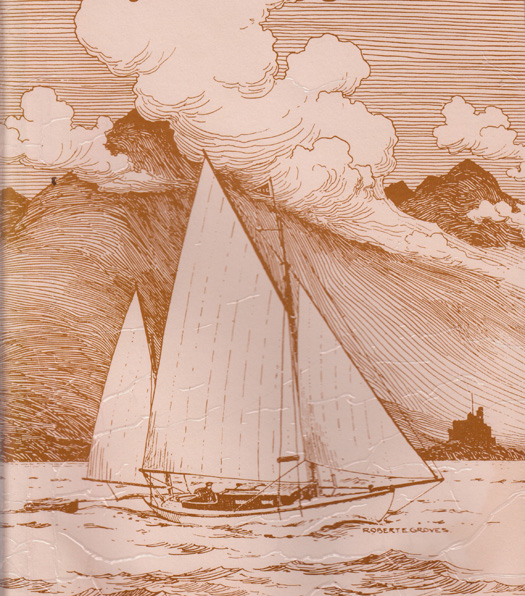
The 25ft Albert Strange-designed gaff yawl Sheila on the West Coast of Scotland in 1909 as sketched by her first owner, marine artist Robert E Groves. Sheila placed second in the Cruiser Class in the Lambay Race of 1921.
Remarkably, both boats still survive, but it is only Sheila which is still in original form. These days she's based on the River Deben in Suffolk on England's East Coast, and as it happens she has just been advertised for sale in prime condition through woodenships.co.uk at £22,000. So if you get your skates on (having won the Lotto), you just have the time to get her to Howth to race again against Ainmara on June 7th.
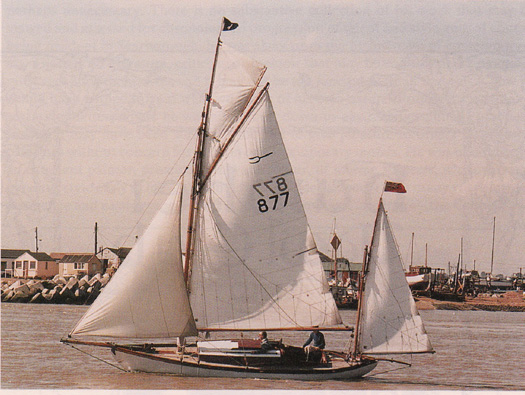
Sheila as she is today in Suffolk, in classic order and for sale at £22,000
Ainmara's hull today is unchanged, but though she was originally noted as a good heavy weather boat with a compact gaff yawl rig and a mainmast only 37ft 6ins long, in the 1930s she was given a massively heavy Bermudan mast. So when owner Dickie Gomes of Strangford Lough was fitting her with an alloy spar which he built himself with the help of specialist friends in the late 1960s, he moved the mast 18ins aft, as John Kearney had originally suggested when he heard – with misgivings – that the change to Bermudan was being made.
Ainmara was in Dublin Bay last year for the inaugural Leinster Plate, so she hopes to be back this year to defend it on May 31st, and then all being well she'll stay on for a week to race again round Lambay on the traditional course on June 7th. To get an idea of how she looked in 1921, this photo of her in 1967 under her first forward-located Bermudan mast is helpful if you can imagine the top third of the Bermudan mainsail removed, and visualise a gaff sail instead, set on a keel-stepped mast whose overall length was only 18 inches longer than the boat's hull LOA of 36ft.

Ainmara in 1967, with the Bermudan mainmast still in the forward position. Try imagining her as gaff rigged, with the mainmast only a little bit longer than the hull. Photo: Denis Pogson
The photo also shows just how very right John B Kearney got his hull lines first time out. Ainmara is one very sweet shape. As Kearney had a fulltime and very demanding job in the engineers department in Dublin Port, his relatively few designs are of special interest, and there's always been particular interest in a design attributed to him from 1924, the 27ft straight-stem yawl Dolphin.
As even a brief study of Kearney designs reveal, he created a distinctive and yacht-like style. The 34ft yawl Sonia, which he designed for, and built with, Bill Blood Smyth in 1929 is essence of Kearney, as we can see from this photo when she was in the ownership of Pierce and Denis Purcell of Dun Laoghaire in the 1940s and '50s.
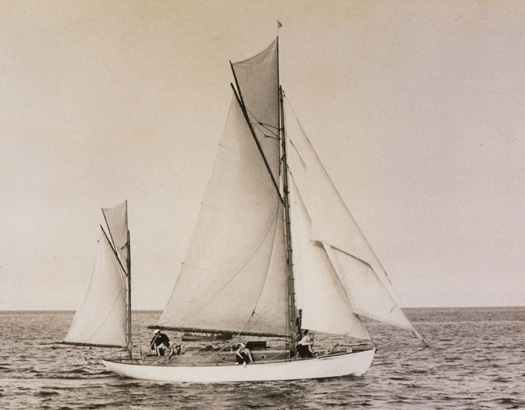
The 34ft 1929 Kearney yawl Sonia (now based in Vancouver) in the ownership of Pierce & Denis Purcell of Dun Laoghaire in the 1940s and '50s, bearing off to oblige the photographer, and showing a remarkably labour-intensive rig with a jib topsail, a topsail on the mizzen, and a topsail on the main. There'd be a mizzen staysail as well, in addition to a spinnaker....... Photo courtesy Pierce Purcell Jnr.
Yet the few written records and folk memories confidently assert that Dolphin is a Kearney design. I can remember her so well from many years around Strangford and Belfast Lough in the ownership of the great Davy Steadman, who once cruised her right round the southern half of Ireland, and then returned as planned through the Shannon and the Grand Canal, no problem as she was shoal daft and had her mainmast in a tabernacle.

Dolphin on Strangford Lough during Davy Steadman's long and happy ownership. Photo: Ann Clementson
The answer to Dolphin's origins came in a real lightbulb moment at the final winter meeting of the DBOGA in Poolbeg Y&BC in March. You never know what's going to come up at these Gaffer gatherings. For instance, I now know in considerable and entertaining detail just why the Castletownbere lifeboat is called the RNLB Annette Hutton, thanks to DBOGA President Tim Magennis having to give us a brilliant impromptu talk when a scheduled speaker failed to show.
At the concluding meeting this Spring, the magic moment came at the end when Cormac Louth suddenly stood up and made an impassioned plea for any memorabilia of any kind at all relating to the fact that between 1818 and the outbreak of the Great War in 1914, there were very strong links between the old fishing community of Ringsend and the great fishing port of Brixham on the south coast of Devon. They were links so strong that today there are many people in Ringsend with Devon surnames, yet there is now virtually no contact between Dublin's most ancient maritime community and the "home port" in southwest England.
It's the sort of nugget of information you squirrel away to examine in detail later. But the lightbulb moment was the sudden realisation that, thanks to the Brixham link, Dolphin might indeed be a John B Kearney design. It's perfectly possible that in 1924 someone asked him to create the plans for a little clinker built cruising yacht whose lines would faithfully reflect the shape of the classic Brixham trawlers, which they'd known in Ringsend for nearly a hundred years.
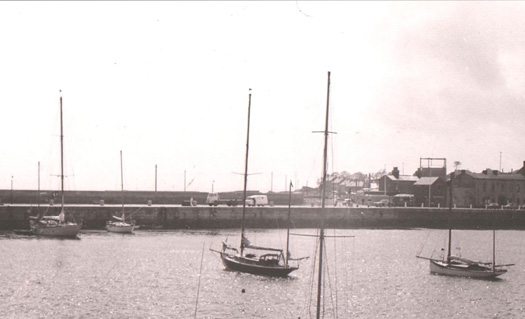
A unique mix of Kearney designs in Donaghadee in 1966. On the left is Perry Greer's 1963-built 54ft Helen of Howth, John Kearney's last and largest design. At mid-harbour is the 36ft Ainmara (1912), his first yacht. And on the right is the 27ft Dolphin (1924), which seems to have been inspired by the classic form of the Brixham trawler. Photo: W M Nixon
Once the Napoleonic Wars ended in 1815, the men of Brixham could start expanding their fishing ambitions, and their increasingly superior boats out-performed most other ports, with the Brixham influence spreading as far east as Ramsgate in Kent, and as far west as Ringsend in Dublin.
With the technological developments accelerated by the World War I, sailing fishing boats were being rapidly replaced by steam and then diesel, but by this time the Brixham vessels had reached an exceptional standard. As big class yachting slowly revived after the war, the regatta circuit made its annual visit to Torquay just across the bay from Brixham. When the skippers of the giant cutters said they couldn't race in the strong winds prevailing as their rigs would become dangerous, the Brixham trawlers contemptuously went forth in full array to show their class, and the Brixham Trawler Regatta came into being.
But with the disruption of the Great War followed by the War of Independence, Ireland's links to Brixham had faded, yet for many in Ringsend, the Brixham trawler remained the ideal, for they were handsome yet able boats. And this gave me another magic moment on a recent Saturday evening in Bridie Keating's pub at Derrynane in far southwest Kerry.
There on the wall, amidst photos of local sailors including Damian Foxall, is an ancient colour photo of the Brixham Trawler Provident. For many years, she was owned by the co-operative known as the Island Cruising Club of Salcombe in Devon, and for most of its members, an annual cruise fetching up in the sublime anchorage of Derrynane, with a spot of conviviality ashore in Bridie's, was what life was all about.
Provident was built in 1924, and so too was Dolphin, and their hull resemblance is startling. Yet it's doubtful if the two boats have ever been together, and it's now unlikely if they ever will be. The last I saw of Dolphin was two years ago in a corner of a little old boatyard near Monkstown on Cork Harbour. Back in 2012, she could maybe have been saved, though only with enormous expense and effort. But it's unlikely that could be done now, yet if she still exists at all, it might be worthwhile to take off her lines.
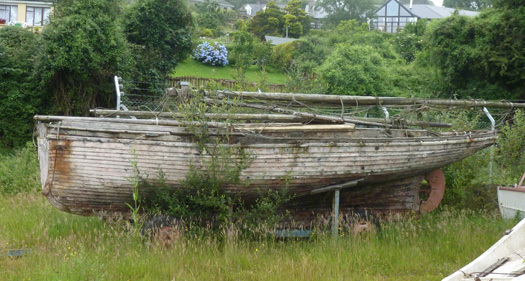
A sad sight. Dolphin in 2012. Photo: W M Nixon

Although clinker construction poses special preservation problems, much of Dolphin's timber seemed in surprisingly good order despite years of exposure and neglect. Photo: W M Nixon
However, the news on the 70ft Provident is good. She's in fine shape after a recent major refit for owners Trinity Sailing Trust, and is based back home in Brixham, the very essence of what a first class Brixham sailing trawler was and is all about.

Provident in all her glory. Owners Trinity Sailing Trust have recently given this historic Brixham-based vessel a complete refit.
Rory Fitzpatrick Wins Howth YC Round of Irish Moth Tour
#moth – Six wins for Rory Fitzpatrick of the National Yacht Club gave him the overall lead in the second round of the Irish Moth tour at Howth Yacht Club at the weekend. The Dubliner discarded a second in the penultimate round of the foiling class to be a clear winner ahead of club mate John Chambers who had three seconds and four thirds in the seven race series (video above). Third was Wexford's Ronan Wallace and fourth the National's Annalise Murphy. Results available to download below.
Two Irish Teams Contest British Team Racing Trophy
#wilsontrophy – Two Irish teams will contest The Wilson Trophy British Open Team Racing Championships are to be held on West Kirby's Marine Lake this weekend (9th – 11th May) and will be hosted by West Kirby Sailing Club (WKSC). Dublin teams from Howth Yacht Club and the Royal St. George YC are travelling to Liverpool for the event now in its 65th year. This unique and spectacular team race sailing event will be welcoming 32 of the finest teams from around the UK, USA and Ireland including three teams from WKSC itself.
Aswell as the Irish participating teams, there will be two Irish umpires at the event. Irish national umpire Cxema Pico is attending and International Judge and national umpire Gordon Davies in also on duty.
The 192 competitors will be sailing in 12-foot dinghies known as Fireflies while under the close observation of some of the best umpires from the UK and overseas. Competition will be fierce this year as some of the traditional teams have disbanded, with sailors joining other teams to try and find that winning formula.
Racing starts at 1pm on Friday 9th May and continues through to late Sunday afternoon. Weather permitting, there will be over 350 fast and cut throat races to watch. The Marine Lake, otherwise known as the 'theatre of dreams', provides a natural amphitheatre where members of the public are encouraged to come and watch the action from the Grandstand on West Kirby promenade (by the old baths). The Visitors Centre and live commentary will also help to explain some of the nuances of the racing to spectators and passers-by.
David Taylor, Commodore of West Kirby Sailing Club, said: "We are thrilled to be hosting this fantastic event, now in its 65th year. It's great to see so many people travelling from near and far to sail on the Marine Lake and enjoy its beautiful surroundings.
"The club is extremely proud to host this event each year and we always aim to provide both the competitors and our local community with a weekend of sporting action that they won't forget."
The three-day event will be an exciting and fun weekend for spectators and competitors alike with a thrilling demonstration of top level sailing, which is free to watch. The final rounds are scheduled to take place on Sunday from 1pm, when the action reaches its climax, with the top eight of 32 teams entering play-offs to take home the celebrated trophy.
The 2014 Wilson Trophy is delighted by the support it has received from many individuals and businesses, including leading sponsors: Carlsberg, Everite Windows, GJW Direct, MI Finance and Speed Medical.
Follow the results at: www.wilsontrophy.co.uk
#isora – The arrival of three Howth Yacht Club boats onto the ISORA scene this season has produced immediate results with HYC entry Dux, an X302 yacht skippered by Anthony Gore-Grimes winning the first ISORA race from Dún Laoghaire to Arklow on Saturday.
Although the strong winds and big seas cancelled most of the local inshore racing for Dublin Bay Sailing Club (DBSC), the 15–offshore yachts came to the line off Dun Laoghaire's East pier in what was some of the strongest breezes of the day. Dux followed by top performing J109 Ruth (Liam Shanahan of the National Yacht Club) made the best of the 40 – knot southerly winds that saw a number of retirals on the upwind leg along the Dublin and Wicklow coasts. Conditions dictated a shortened course to the Wicklow outfall buoy instead of North Arklow, a reduced distance of some 38 miles instead of 50 that produced an early (and welcome) high speed reaching leg back to Dublin Bay.
The provisional results for Race 1a - the Dún Laoghaire day race (incorporating the first Royal Alfred Yacht Club Coastal Series) is available to download below as a jpeg file.
In a move that has drawn the international support of ISAF's offshore working party, the ISORA crews are experimenting with iphone navigation during the race and 'virtual marks' to adjust the courses.
In deploying the new mobile technology ISORA has teamed up with app developer 'Predict Wind Tracker'.
Unfortunately on Saturday, ISORA did not get to use them to full effect. The weather was so awful that the basis of the course was to keep as close to land as possible but away from banks and headlands.
This, says Peter Ryan of ISORA, is a cost effective method of recording any offshore race that can be viewed live and also replayed after the event. ISAF's David Brunskill has offered to judge any issues surrounding the use of the virtual marks.

First race winner Dux sailed by seasoned campaigner Anthony Gore-Grimes' Photo: Robert Bateman
Ryan adds that if the innovative approach to setting courses is successful, 'it will radically change offshore racing to the betterment of all', a sentiment supported by the world sailing body.
The next race is the Holyhead to Dún Laoghaire qualifying race on 10th May. This is followed by the return race from Dún Laoghaire to Holyhead on 24th May. One of the highlights of the ISORA series this year is the Midnight Race from Liverpool to Douglas on 6th June.
Strengthen Fingal's Freedom for the Good of Irish Sailing
#fingal – The Government's recent move to create a framework for the direct election of a new all-powerful Mayor for Dublin was expected to be a shoo-in. The new Super-Mayor's authority would incorporate the current four local councils of Dun Laoghaire-Rathdown, South Dublin, Dublin City, and Fingal, each one of which had to vote in favour. But Fingal's councillors voted firmly against it, despite emphatic support of the proposal by the councillors in the other three areas. As a Fingallion by adoption, W M Nixon strongly supports this independent move by a largely rural and coastal region which has a longer shoreline than all the other Dublin areas put together, and is clearly not a naturally integral part of the city.
Fingal is the Ukraine of Leinster, and the glowering monster of Dublin is the Russia within Ireland, intent on the conquest of its smaller freedom-seeking neighbour. Vigorous, all-powerful, intensely urban, and distinctly impressed with itself, Dublin is certain that the further its bounds are spread, the better it will be for all its citizens. And the more citizens it can claim, then the better for Dublin.
But Fingal is different. For sure, it can seem a bit sleepy and rural by comparison with central Dublin, but that's the way we like it. It's a place of odd little ports and much fishing, a region of offshore islands, rocky coasts and many beaches on one side, and the profound heart of the fertile country on the other. A place where – as you move north within it - you might make a living in many ways at once, taking in growing vegetables, raising animals, running a dairy herd, and keeping a lobster boat down at the local quay, while perhaps having a horse or two as well. And if you feel like more shore sport, the golfing options are truly world class.
As for the sailing and all other forms of recreational boating, Fingal is not just a place of remarkable variety – it's a universe. With five islands – six if you count Rockabill – its 88 kilometre coastline is one for sport, relaxation and exploration. Sea angling is well up the agenda, and it's a kayakers' paradise, while Irish speed records in sailboarding and kite-surfing have been established in the natural sand-girt canal which forms for much of the tidal cycle in the outer Baldoyle estuary immediately west of Howth.
Apart from fishing boats – and inshore they're usually only the smaller ones – it has no commercial traffic. And though there are tidal streams, in southern Fingal's main racing area between Ireland's Eye and Lambay, they're not excessively strong, and run in a reasonably clear-defined way, while the flukey winds which so often bedevil Dublin Bay away to the south are much less of a problem in sailing off Fingal, where the winds blow free.
The range of boat and sailing clubs of Fingal matches the variety of its coast. The most southerly is Sutton Dinghy Club, rare among Ireland's yacht clubs in being south-facing. It may be focused on sailing in Dublin Bay, but scratch any SDC sailor, and you'll find a Fingallion. Round the corner of the Baily – not a headland to be trifled with - Howth has two clubs, the yacht club with its own marina, and Cumann na Bhad Binn Eadair (the Howth Sailing & Boat Club) in the northeast corner of the harbour, while Howth Sea Angling Club with its large premises on the West Pier is one of the tops in the country.

The sunny south. Sutton Dinghy Club is Fingal's most southerly sailing club, and is also rare in Ireland through being south facing.
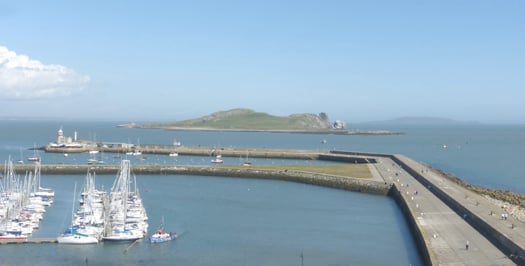
Islands of Fingal seen across the eastern part of Howth marina, with Ireland's Eye in the foreground, and Lambay beyond. Photo: W M Nixon
As for the waters they share, their most immediate neighbour is the steep island of Ireland's Eye with its pleasant southwest-facing beach, the island itself a remarkable wild nesting site, particularly when you remember that it's close beside an intensely urban setting. When a discerning visitor described Ireland's Eye as "an astonishing and perfect miniature St Kilda", he wasn't exaggerating.
Across in Malahide, where we find Fingal's other marina, Malahide YC - which recently celebrated its Golden Jubilee and currently has Graham Smith as its first second-generation Commodore – is in the curious position of having two clubhouses. One is a charming and hospitable place among trees within easy stroll of the marina, while the other is west of the long railway embankment which retains the extensive inner waters of Broadmeadow. This makes the waters into a marvellous recreational amenity and boating and sailing nursery, so not surprisingly it is home to active sailing schools. And it is also the base of Malahide YC "west", a dinghy sailing club on the Broadmeadow shore at Yellow Walls, while further west of it again is yet another club, the more recently formed Swords Sailing & Boating Club.

The map of modern Fingal shows how the southwest corner of the present region seems remote from the largely coastal and rural nature of much of the rest of the county. And it also confirms the surprise (to many) that the Phoenix Park is in Fingal.
North from Malahide, and you're into "Fingal profonde", its deeply rural nature occasionally emphasised by the sea nearby. The long Rogerstown Estuary, the next inlet after Malahide, sometimes found itself providing the northern boundary of The Pale, and as recently as the early 1800s the river at Rogerstown and the tiny port of Rush were a veritable nest of smugglers, privateers and occasionally pirates, with buccaneering captains of myth and legend such as Luke Ryan and James Mathews proving to have been real people who were pillars of society when back home in their secretive little communities after their lengthy business forays to God know where.

Muddy situation. Low water in the Rogerstown Estuary. The hill in the distance on the left is new – for years, it was the largest dump in Ireland, the Balleally Landfill. But now it is well on its way to rehabilitation as an enhancement of the landscape. Photo: W M Nixon
The Rogerstown Estuary went through an unpleasant period when its inner waters were dominated by the nearby presence of the biggest waste dump in Dublin, Balleally Landfill. It rose and rose, but now it's closed, and is in process of being revived to some sort of natural state. The result is that the vista westward from Rogerstown is much improved by a pleasant and completely new hill which so enhances the view at sunset that shrewd locals have built themselves a row of fine new houses facing west, along the quirkily named Spout Lane which runs inland from the estuary.
Whatever about the legality-pushing privateer skippers who used Rogerstown Estuary as their base in days of yore, these days it's home to the quay and storehouse which serves the ferry to Lambay, which is Fingal's only inhabited island when there are no bird wardens resident on Rockabill, and it's also the setting for another south-facing club, Rush SC. It is spiritual home these days to the historic 17ft Mermaid Class (they still occasionally build new ones in an old mill nearby), but despite the very strong tidal streams where the estuary narrows as it meets the sea, RSC also has a large cruiser fleet whose moorings are so tide-rode that unless there's a boat on the buoy, it tends to disappear under water in the final urge of the flood. This can make things distinctly interesting for strangers arriving in and hoping to borrow a mooring while avoiding getting fouled in those moorings already submerged. Not surprisingly, with their boat sizes becoming larger like everywhere else, Rush SC find that their bigger cruisers use Malahide Marina.
To seaward of Rogerstown, with the little port of Rush just round the corner, the view is dominated by Lambay. A fine big island with is own little "miniature Dun Laoghaire" to provide a harbour on its west side, it has a notable Lutyens house set among the trees. But for many years now Lambay has been a major Nature Reserve, so landing is banned, though anchorage is available in its three or four bays provided you don't interfere with the wildlife along the shore. This makes it off bounds to kayakers who might hope for a leg stretch on land, though it's still well worth paddling round close inshore.
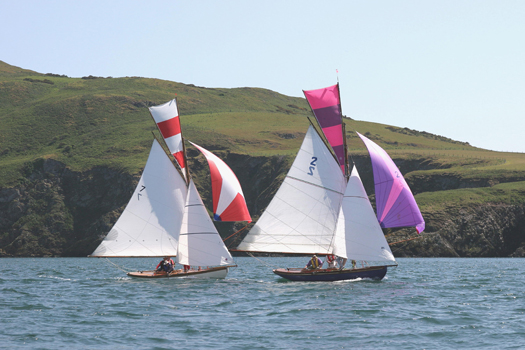
Racing round Lambay. Close competition between the Howth 17s Aura (left) and Pauline, which have been racing annually round Lambay since 1904. Photo: John Deane
Along the Fingal mainland coast, the next inlet after Rush is Loughshinny, a lovely natural harbour with a quay to further improve the bay's shelter. There's a very active little fishing fleet, while the shoreside architecture is, how shall we say, decidedly eclectic and individualistic? Go there and you'll see what I mean.
Six miles offshore, Rockabill marks the northeast limits of Fingal. It's a fine big double-rock, with a substantial lighthouse and characterful keepers' houses attached. But as it's now automated, the only time Rockabill is inhabited is for the four summer months when a bird warden or two take up residence to monitor the rocky island's most distinguished summer residents, Europe's largest breeding colony of roseate terns.
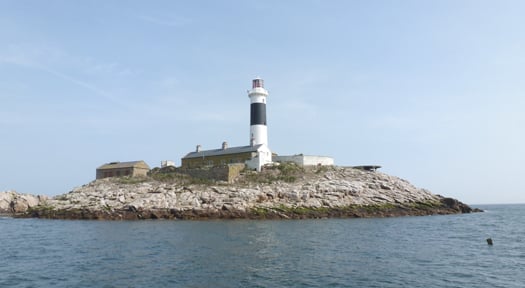
Rockabill, where the shy roseate terns feel at home. Photo: W M Nixon
In Fingal we tend to take these pretty but noisy summer visitors for granted, but the word is that south of Dublin Bay the tern buffs are so incensed by Rockabill having a clear run that they're tried to start a rival colony of roseate terns on the Muglins, and built a row of tern houses (one good tern deserves another) to facilitate their residence. The potential nest sites may not have survived the past severe winter. But in any case, one wonders if they had planning permission from Dun Laoghaire/Rathdown council for this development? Persons suggesting that such a development would almost certainly be terned down will not be given any attention whatsoever.
Skerries and Balbriggan are the two main sea towns of north Fingal, and they're as different as can be, the difference being emphasised by historic rivalry. It's said that back in the government harbour-building days of the late 19th Century a grant was made available to assist local landowners to make significant improvements to one of the harbours, and this meant war.

Balbriggan may very definitely dry out, but it provides a secure home port for both trawlers and other boats prepared to settle on the mud and sand. Photo: W M Nixon
So eventually the grant was split with half going to improve Balbriggan, and the other half to Skerries, with neither being a total success. If you seek total shelter in either today, you have to be prepared to dry out, while the anchorage off Skerries is also subject to a large tidal whorl which means that when the ebb is running in a strong onshore wind, the moorings are doubly rough and diabolically uncomfortable. And every so often after an exceptional nor'easter, we have another litany of boats driven ashore and Skerries yacht insurance going even further through the roof.
It's a situation which needs proper attention from an administration which is genuinely interested in the port. And the proper development of the harbour at Skerries, while retaining the little old place's special character, is surely something which could be much better done by Fingal Council rather than some remote Mayor of Dublin for whom Skerries will be the outermost periphery, a place seldom visited, if at all.
We've seen it all before. Time was when Fingal was simply the North County, little noticed in the centres of power which were basically Dublin City and Dublin County, their head offices in the heart of the city. But then in 2001 the new four-council setup was created, and the old name of Fingal – never forgotten by those who cherished the area – was revived. A very fine new user-friendly County Hall – it has even been praised by Frank McDonald of The Irish Times – was built in the re-born county town of Swords. Out on the new boundaries meanwhile, the signs went up saying "Welcome to Fingal County". But we old Fingallion fogeys pointed out that as Fingal means "Territory of the Fair Strangers" (i.e the Norsemen rather than the Danes), it was superfluous to be describing it as "the county of the territory", so these days it's just Fingal, and we're happy with that.
Here in Howth, we sort of slipped into acceptance of the new setup. Once upon a time, from 1917 to 1943, Howth had its own Urban District Council. It says much for the place's remoteness from the world that the HUDC was established in the midst of one global war, and quietly wound up in the midst of another. In 1943, Commissioners had to be imposed on the tiny fiefdom to offset the fact that some local interests thought the HUDC existed entirely for their own personal benefit. So at various times since, Howth was run either by Dublin County Council, or even by Dublin City Corporation. We were assured that this latter setup was all to our benefit, as the powers-that-be in City Hall had a soft spot for Howth, sure wasn't it the place where the mammy went every Thursday evening to buy the family's fish, and wouldn't she want to see it looking well?
Maybe so, but when it came to doing something more useful with the harbour, Howth Yacht Club – having re-constituted itself in 1968 from an amalgamation of Howth Sailing Club (founded 1895) and Howth Motor Yacht Club (founded 1934) - found itself dealing with a bewildering variety of government departments as the lowly interests of fishing and its ports seemed to be shifted whenever possible by civil servants who reckoned that banging the drum on behalf of fisheries in particular, and maritime interests in general, was not a shrewd career move for anyone planning a steady progress up the very landbound Irish public service ladder to the sunlit uplands of a long and prosperous retirement.
So if at times absolutely nothing seemed to be happening in a harbour which was painfully inadequate for expanding boating and fishing needs, it was partly because the club officers and fishermen's leaders could find it difficult to discern just who in authority could or would make the decisive call. In those days it turned out to be somewhere in the hidden recesses of the Office of Public Works. Suddenly, in 1979, a plan for the major re-development of the harbour was promulgated at official level, with a radical rationalisation planned for its future use. The western part, it was proposed, would become totally fisheries, while the eastern part was to be given over to recreational boating, all of it involving major civil engineering and harbour works projects.
Looking at the successful harbour today, it all seems perfectly reasonable and sensible. But back in 1979 when HYC were presented with a time-limited take-it-or-leave-it choice, the way ahead was not at all clear. Friendships were sundered and family feuds emerged from the heated progress towards accepting the offer that the club agree to vacate its premises on the West Pier - a clubhouse which it had renovated and extended only ten years earlier – and commit itself to the installation, at members' cost, of a marina in the eastern harbour with the obligation to build a completely new clubhouse there.

Today's Howth Harbour didn't happen overnight. This is how it was from 1982 until the new clubhouse was completed in 1987. Photo: W M Nixon
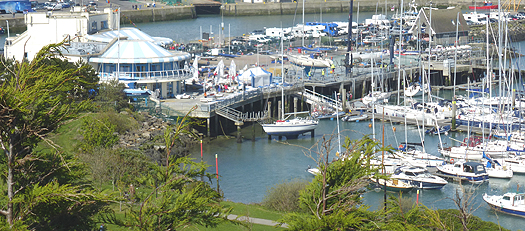
Multiple activities under way at Howth YC this week. The club's setup may seem only natural now, but it was quite a struggle to get there. Photo: W M Nixon
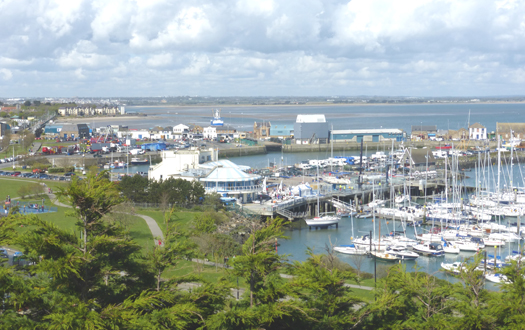
Howth's vibrant mix of a working fishing port and busy sailing centre has provided the ideal setting for the development of a successful visitor and seafood destination. Photo: W M Nixon
It's all history now, but it was done. And done so well by those involved that today it's simply taken for granted. Arguably, it's a compliment to those who created the Howth YC setup, that newer members should seldom wonder how it all came to happen, it just seems so right and natural. And as for those running the club, they in turn have to build on past achievements in dealing with an ever-changing administrative environment in which the changeover to being part of Fingal was only one of several evolutions.
Yet the recent attempt to abolish Fingal was a wake-up call. In Howth we may have wandered into it, but in just a dozen years, a dormant Fingal identity has come quietly but strongly awake. In Howth village it's natural enough, as our backs are turned to Dublin and we look to the rest of Fingal. But even on the south side of the hill, where fine houses face across Dublin Bay and you'd expect a sense of identity with households in similarly choice locations for all that they look north out of Dun Laoghaire, you find that the attraction of visiting the southside has the exotic appeal of going foreign, while those of us more humbly placed in the village, if visiting remote places like Rathmines or Terenure, find it positively unnerving to think of all the houses between us and the sea.
Then too, while Fingal Council has been establishing itself in our hearts and minds, it has been a good time for Howth Harbour. Good fences have been making good neighbours, and though marine administration in government has been kicked from pillar to post, an underlying Department of Fisheries recognition that their harbours cannot be only about fishing has led to a re-think on the use of buildings about the harbour, with Howth becoming an extraordinary nexus of good seafood restaurants, such that on a summer evening, despite the presence of a traditional fish and chip shop, the seafood aroma is of a proper fishing port in Brittany or Galicia. In fact, rents from the hospitality and sailing and marine industries in Howth have now reached such a level that fish landing fees – formerly the bedrock of the harbour economy – only contribute about 10% of the overall income.

The man from County Hall. Fingal Mayor Kieran Dennison is comfortable with his county's busy sailing activities, and the sailors are comfortable with him. He is seen here officially opening the J/24 Worlds at Howth in August 2013. Photo: W M Nixon
As for how we've been getting on with our new masters in County Hall up in Swords, the news is good. Most recently, we've been having direct contact with the current Mayor of Fingal, Kieran Dennison, who hit just the right note when he officially opened the J/24 Worlds in Howth in August 2013. Following that, he was back at the annual Commodore's Lunch in HYC in the dark days of November when a review of the past season lightens the onset of winter, and he was able to tell us that thanks to contacts made at the Worlds, his invitation to visit the America's Cup in San Francisco in September was made even more enjoyable. Those of us who reckoned the only way to visit the 34th America's Cup was on the television screen were reassured by the thought that if somebody was going to represent us in the San Francisco bear-pit, then our Mayor, our very own Mayor of Fingal, was just the man for the job.
So we very much want to keep Fingal in existence and in robust good health, but we appreciate that its current boundaries might be creating a bit of a Ukraine-versus-Russia situation. In particular, the southwest of the county could well be Fingal's Crimea and Donetsk regions. There, relatively new settlements of ethnic Dubs in places like Clonsilla, Castleknock, Blanchardstown could become such a source of trouble that it might be better to transfer them peacefully to administration by either Dublin city or South Dublin before there is unnecessary bloodshed.
The situation arises because, when the boundaries were being drawn, southwest Fingal was set out all the way down to the Liffey. The Fingallion instinct would be to see the border drawn along the Tolka, in other words the M3. But there could be trouble because of the discovery – always something of a surprise – that the Phoenix Park is in Fingal. I could see that when some people find our Fingal includes the Park, they'll want to fight for it, particularly as, in the southeast of the county, the excellent St Anne's Park in Raheny was somehow allowed to slip into Dublin City.
One thing which is definitely not for transfer is the Airport. It is naturally, utterly and totally part of Fingal. For sure, it contributes a fifth of the county's annual income from business rates, making Fingal the economically healthiest Irish county. But we in Fingal have to live with the airport very much in our midst. If Dublin really wants to take over the airport, then a first condition before negotiations even begin would be that all flight paths are to be re-routed directly over Dun Laoghaire and Dalkey. A few weeks of that would soon soften their cough.
Whatever, the recent kerfuffle about Fingal rejecting involvement in administration by an all-powerful Mayor of Dublin has been a powerful stimulant to thinking about how our own county might best be run. Everyone will have their own pet local projects, and most of us will reckon that decision-making in Swords, rather than in some vast and impenetrable office in the middle of Dublin, will be the best way to bring it about. For those of us who go afloat, the fact that Fingal Council shows that it cherishes its long and varied sea coast, rather than preferring to ignore it, is very encouraging. And the fact that this prospering county has some financial muscle all of its own gives us hope that we can build on what the past has taught us, and spread improved facilities to every port. Should that happen, it will in turn benefit Irish sailing and boating generally to a greater extent than would restricted development under one closely-controlled central administration headed by some southside megalomaniac.
Cork Harbour's Guilfoyle Leads Lasers at Youth Nationals
#youthsailing – Fresh from his significant 15th overall a week ago at the Laser Europa Cup in Marseille, Royal Cork's Seafra Guilfoyle took a three point lead after the initial three races in today's opening rounds of the youth national championships off Howth. Guilfyole has a 3, 1, 1 putting him in pole position ahead of Kinsale's Ross O'Sullivan and Royal Cork club mate Cian Byrne, who were also competing in France.
420 dinghy locals Robert Dickson and Sean Waddilove won the first two races and finished second in the final race of the day in the double–handed class. They lead Royal Cork's Harry Whitaker & Grattan Roberts and Peter McCann & Arran Walsh.
Full results here.
#hyc – Up to 250 of Ireland's top young sailors sail from the Fingal port of Howth in County Dublin this morning for the annual four-day Youth National Championships. Three separate race areas will be laid north of Ireland's Eye in order to accommodate the large number of competitors.
From the 24th to the 27th of April, Howth Yacht Club is hosting the annual youth sailing event on the domestic calendar.
In the Laser Radial class, many of last year's top performing sailors have progressed on to the senior Standard class. This has opened up the competition to the new wave of younger ambitious athletes eager to take the prized podium places. In the two-person 420 class, locals Robert Dickson and Sean Waddilove will be the ones to watch. The 2013 champions are currently in transition year and have spent their academic year studying in France where they have also been able to put in a lot of training and competition time on the water.
On a separate race course for the week, the 60 strong Optimist fleet will contest the first leg of their annual trials for representing Ireland abroad at a host of summer events. One of the pinnacle events will be the Optimist European Championship which this year will be hosted in Ireland by the Royal St George Yacht Club in Dun Laoghaire. With just under three months to go to the opening ceremony there are currently 250 registered sailors in the Dun Laoghaire event from 43 countries from as far afield as Bermuda, Japan, India and Iceland. They will arrive with 80 coaches and support personnel and many travelling with their families.
The ISA championships will also be complemented by Howth's annual Dublin Bay Prawn Festival, which will see the entire harbour front filled with tents and stalls offering various culinary delights related to the world-famous crustaceans. There will also be a carnival on the green of the harbour for the children and their families.




























